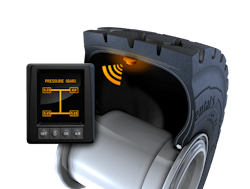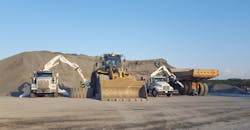Tire Technology Can Trim Operating Costs
Titan International’s Accelerated Change Technology (ACT) wheel was a considerable draw for the company at its Conexpo 2017 display, especially for fleet managers who must deal with what one manager described at those “pesky inner drive tires on mining trucks.” According to John Francis, Titan’s global OTR (off-the-road) product manager, the ACT wheel (also called “quick-change rims”) can save truck owners up to 50 percent of the time typically spent changing these large tires. Titan’s ACT wheels, he says, are compatible with any brand of OTR tire that uses a 51-, 57-, or 63-inch-diameter wheel.
“The technology simply allows the technician to rotate or change the inside tire without having to take the outside rim off the unit,” says Francis. “The advantage is that, once installed, there’s no need to remove nuts or clamps to rotate the tires off and on the haul truck. When an inside dual tire needs to be changed, it simply slips over the outer dual wheel.”
Above: Titan International’s Accelerated Change Technology (ACT) allows the technician to change the inside tire without having to take the outside rim off the unit, reducing service time as much as 50 percent, says Titan.
Titan’s ACT system illustrates how OTR-tire manufacturers, generally, keep advancing tire and wheel technology, whether with new application-specific rubber compounds, new designs (such as the low-sidewall concept), easier-to-use tire-tracking programs, smart tires that communicate pressures and temperatures via telematics, or even with more “comfortable” tires.
“Operator comfort is a growing issue in the tire business and among our customers,” says Dean Hill, general manager, Cy-Fair Tire, Houston, Texas. “Buyers who need puncture protection, for example, often are opting for foam-filled versus solid tires.”
Seth Walters, manager, special product programs, Alliance Tire Americas, makes the point, however, that solid tires with apertures make the ride more comfortable, as do new solid-tire designs that feature a “three-stage construction” that combines a stable base compound, durable tread compound, and a center cushioning compound, such as the company’s Galaxy Yardmaster SDS.
More on tire management
Ride comfort is also a factor in the design of conventional pneumatic tires says Dilip Vaidya, president and director of technology at BKT.
“Our research confirms that tire buyers consider comfort a key aspect for the productivity of their businesses,” says Vaidya. “A comfortable tire increases the operator’s confidence and reduces fatigue, resulting in enhanced productivity. A comfortable tire has a number of qualities—a softer ride, of course, but also qualities that reduce vibration, diminish noise, and improve such factors as stability, steering, and braking. In general, refinements in radial-tire design continue to enhance the comfort of operators, given that the flexibility of the radial tire’s sidewall during operation is independent from the activity of the tread.”
Along with OTR-tire designs that are aimed at overall operator comfort in the interest of productivity, OTR tires in some instances are becoming more intelligent, able to report conditions that might threaten their health and the safety of the machine operator.
For example, Continental Commercial Specialty Tires equips all tires in its ContiEarth range with an integrated sensor that continually monitors pressure and temperature (left). The sensor in these “iTires” transmits this information in real time to the ContiPressureCheck system, which can display the numbers in the machine cab and on a hand-held tool. A fairly recent development in the Continental monitoring system is the company’s ContiFlexBox, which gives the system telematics capability.
Information from the tire sensors is transmitted wirelessly to an onboard central control unit/receiver that is connected into the machine’s CAN Bus system. Data is then transmitted to the machine’s in-cab display and to the ContiFlexBox, which, says the company, transmits information to a central server for analysis and editing. According to Continental, the system is “compatible with tubeless tires from all manufacturers’ brands, and for vehicles of every size.”
According to Rob Seibert, marketing manager, OTR tires, Bridgestone Americas Tire Operations, the Bridgestone Intelligent Tag (B-TAG) system is a pressure/temperature monitoring system designed for tires with wheel diameters of 51 inches or larger. The updated B-TAG system with DirectLink, he says, allows users to display real-time and historical temperature and pressure data via a web-based interface on computers, tablets, and phones.
Michelin’s monitoring system, MEMS (Michelin Earthmover Management System) Evolution3, is designed for mining-truck application and enables tires to communicate temperature and pressure in real time, says the company, and sends alerts via various media, including the Internet, email, and SMS [short message service].
Tire tracking
Tire technology extends also to systems that assist machine owners with managing these expensive tire assets for lower costs. More tire users seem to be recognizing the value of tire-tracking, and tire manufacturers are responding with programs that make on-site collection of tire data simpler and faster, while also enhancing the immediacy and usefulness of that data. Michelin, Bridgestone, and Goodyear, for example, have all recently refined their tire-tracking programs (Tire Care, TreadStat, and EM Track, respectively).
Tire-tracking, essentially, is a system for which the tire user usually pays a fee to have the tire dealer periodically check and set pressures in the fleet’s tires, measure tread depth, and inspect for damage and abnormal wear. This information is recorded and applied to an online database, and the dealer, employing the tire manufacturer’s proprietary software, uses the data to advise the tire owner of immediate needs, as well as to provide various reports.
“The Bridgestone TreadStat system provides a full suite of reports to help tire users understand their entire operation,” says the company’s Seibert, “such as projections of tire needs, inventory status, out-of-service projections, and repair status. The tire-tracking system also allows diving deeper into the data, providing a look into every tire in the fleet—including its remaining tread depth, hours of service, and location.”
“Tire-management programs have been around for a long time,” says Jamey Fish, director of marketing, Michelin Earthmover, NA., “but these programs are now changing rapidly as technology evolves. The name of the game is to get the longest tire life possible at the lowest cost, because managing all the minute details that surround this is what determines profitability. As the industry turns for the better and everyone gets busy again, tire programs are going to become critical.”
Michael Dembe, product management director, North America, for Camso’s construction business unit, is in agreement. “Regardless of equipment size, tires are among the most expensive of consumables, and it makes sense for users with sizeable fleets to pay close attention to tire selection and management. Tire-tracking software can yield many benefits, and if the software is available, and the tire dealer is willing to implement it, smaller fleets and owners of compact equipment should be encouraged to also use tire-tracking.”
Bridgestone completely updated the software package in 2017 for its TreadStat tire-tracking and wheel-management system, says Seibert—a system the company initially developed some 10 years ago.
“The system’s basic function remains the same—understanding the current status of tires in the fleet and forecasting tire requirements,” says Seibert. “The new update, however, provides customized dashboards to better understand the details of tire-related costs. The update also moves to mobile inspection, providing an app that allows on-site data to be digitally recorded and uploaded via the cloud. It eliminates paper and allows inspections to be made with greater efficiency.”
Goodyear’s tire-tracking program, EM Track—EM for EarthMoving—has been available on a global basis for many years and has continually evolved to meet user needs, says Eric Matson, manager of global field engineering.
“EM Track is designed to be simple and intuitive to use,” says Matson, “and will soon feature an app that will allow digital recording of on-site data and sync’ing to the system. The new system will make the inspection process—tread depth, pressure, and any sort of damage or irregular wear—easier and more efficient.”
Among the most significant benefits of tire tracking, says Matson, is the ability to help manage inventory.
“Tire tracking gives the ability to run a reduced inventory,” says Matson. “I can’t image a quarry or a construction company with more than four or five trucks not involved in a tire-performance tracking program. Without such a tracking program, the operation might have to inventory multiple tires of every size—just in case—because they could have no idea what tires are due to come off. But when you have the level of visibility into your fleet that tire tracking provides, you know how many tires you’re using per quarter, for example, and you don’t need all that cash tied up in inventory.”
According to Michelin’s Jamey Fish, the “how” of in-field data collection for tire tracking has always been a bottleneck of sorts in the process.
“In the past, the servicing dealer had to stop the machine for a period of time to manually collect data, and the process was laborious and time-consuming,” says Fish. “Information was collected on a tablet, or maybe even paper, then needed to be manually loaded into a database. Michelin has significantly improved the process with its TireCheck tool.”
The TireCheck system, says Fish, uses a Bluetooth tread-depth gauge, a wireless “pressure stick,” and an Android smart phone.
“Information is collected by a customized app on the technician’s cell phone,” says Fish. “The app reads the Bluetooth sensor and pulls the data off the instrument and instantly transmits the information into the cloud. The database then feeds the appropriate reports to the customer.”
Michelin’s Rodrigo Alonso, Infra Services and development distribution, says that the TireCheck system both speeds up the data-collection process and improves the accuracy of data.
“The technician shows up on site with TireCheck technology—wireless tread-depth and air-pressure gauges—scans a barcode on the machine, and the system instantly brings up the data on the machine and its history,” says Alonso. “The entire inspection process takes maybe five to eight minutes. The system saves downtime, increases productivity, and provides more accurate data, because you’re not trying to write things down on paper in the cold.”


